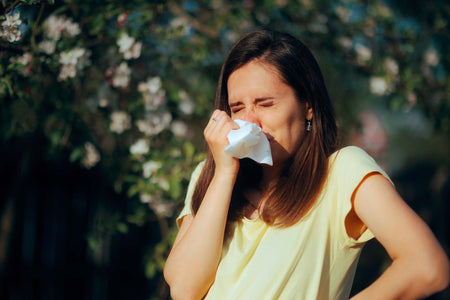- Fall allergies often cause symptoms of nasal congestion, runny nose, sneezing, and itchy eyes.
- Triggers can include ragweed pollen, mold spores, and dust mites.
- Nasal sprays and taking proactive steps are beneficial for effective management.
Fall allergies can be just as troublesome as spring and summer allergies, but their triggers are different. As the weather cools and the days grow shorter, new allergens come into play.
If you have a history of allergic rhinitis or live in certain environments, you may be prone to experiencing symptoms during the fall. Managing fall allergies starts by understanding their causes and how they manifest. Here’s what you need to know.
When Do Fall Allergies Start and End?
Fall allergies typically start in late summer, around late August or early September, when there is a noticeable shift in weather patterns from summer heat to cooler temperatures. This transition period triggers the release of allergens from various sources, both outdoors and indoors.
In some regions with milder climates, fall allergies may extend into early winter, depending on local environmental conditions and allergen exposure levels.
What Causes Fall Allergies?
Fall allergies are primarily triggered by a combination of allergens, prominently including ragweed pollen, molds, and dust mites.
Here’s a description of each trigger:
- Ragweed. These plants typically germinate in the spring and die after the first frost in late fall. Despite only living for a few months, their impact on allergy sufferers is substantial. Each ragweed plant can produce up to 1 billion pollen grains during its short life, and grains can float easily through the air. When inhaled, it can cause reactions in sensitive individuals [*].
- Mold Spores. Mold thrives in damp environments and is prevalent throughout the fall. As temperatures cool and humidity levels remain moderate, molds release airborne spores that can trigger allergic reactions when inhaled. Although prevalent in outdoor environments they can also enter indoor spaces through open windows or on clothing.
- Dust mites. These are microscopic organisms that live in upholstery and house dust, feeding on dead skin cells. While they’re commonly associated with indoor allergens, they can exacerbate symptoms during the fall season as people spend more time indoors with windows closed. It’s important to note that no home is completely free of dust mites, but people can take steps to manage their presence [*].
Fall Allergies Symptoms
Fall allergy symptoms can vary from person to person but commonly include:
- Nasal congestion
- Runny nose
- Sneezing
- Itchy and watery eyes
- Itchy nose
- Scratchy throat
These symptoms can range from mild to severe and may interfere with daily activities and quality of life. They can make it difficult to fall or stay asleep, and hard to concentrate at work. For those with asthma, fall allergens may trigger asthma attacks [*].
How are Fall Allergies Diagnosed?
A healthcare provider will first conduct a thorough interview to understand when your symptoms have started, how long they last, and what seems to trigger or worsen them. Your doctor will also examine your nasal passages, throat, eyes, and breathing to check for signs of an allergy.
Additional tests may include allergy skin testing, blood tests, a nasal smear, and pulmonary function tests. These tests will help confirm whether allergens like pollen, molds, or dust mites are causing your allergic reactions. They serve as a basis for coming up with a treatment plan.
How to Treat Fall Allergies
Treating fall allergies requires a combination of approaches for better symptom management. Different allergy medications can help, such as nasal sprays, eye drops, and antihistamines. Speak with your doctor about these medications.
Here are some effective ways to treat fall allergies:
Oral antihistamines
Histamines are chemicals produced by the immune system in response to an allergen, and antihistamines work by blocking histamine receptors (specifically H1 receptors) on cells. The result is that histamines are unable to bind to these receptors, which leads to symptom relief.
The main types of antihistamines include:
- First-generation antihistamines. These antihistamines are older and have the tendency to cause drowsiness since they cross the blood-brain barrier. Some examples include diphenhydramine and chlorpheniramine.
- Second-generation antihistamines. These are newer and generally cause less drowsiness because they do not cross the blood-brain barrier as easily. Common examples include cetirizine, loratadine, and fexofenadine.
- Third-generation antihistamines. Like second-generation antihistamines, these are newer antihistamines. They’re designed to be even less sedating and have fewer side effects. Examples are desloratadine and levocetirizine.
Related: Decongestant vs. Antihistamine
Nasal sprays
Nasal sprays help with fall allergies by delivering medications directly to the nasal passages, where allergens like pollen and mold spores can trigger inflammation and symptoms. Most allergists prefer the use of nasal sprays to oral antihistamines since they tend to be more effective and there is less medicine absorbed into the body systemically.
Different nasal sprays can be formulated from various ingredients depending on their intended use. Saline nasal sprays, for example, is a solution consisting of sodium chloride and purified water to moisturize dry nasal passages.
For those seeking comprehensive nasal relief, consider Allermi. This advanced nasal spray combines the benefits of multiple treatments into one convenient solution. Its unique formulation addresses a broad range of fall allergy symptoms.
Related: How to Use Nasal Sprays Correctly
Eye drops
Eye drops help with fall allergies by offering relief from symptoms such as itching, redness, swelling, and watering of the eyes caused by allergens like pollen or mold spores. They provide targeted relief directly to the affected area.
Allergy shots
Allergy shots are a long-term treatment option for managing fall allergies. Through a series of injections containing small amounts of allergens, the immune system gradually becomes less sensitive to allergens like pollen or mold spores. Allergy shows might reduce the need for medications to manage allergies.
Related: What to Do When Allergy Medicine Doesn’t Work
Tips to Combat Fall Allergies
Combatting fall allergies involves proactive steps to minimize exposure to allergens. Here are some tips that help:
- Limit outdoor activities when pollen counts are high. This will minimize your exposure.
- Shower and change clothes after spending time outdoors.
- Keep windows and doors closed during peak allergy season.
- Use HEPA filters in your home's heating and cooling systems to trap allergens like pollen and mold spores.
- Regularly clean your home to reduce allergens. Vacuum carpets and upholstery frequently.
- Use a dehumidifier to keep indoor humidity levels below 50%, which helps prevent mold growth.
- Wash bedding, including sheets and pillowcases, in hot water (at least 130°F) weekly to kill dust mites.
- Wear a pollen mask to reduce inhalation of allergens.
Combine multiple strategies to manage your symptoms more effectively. It’s also best to consult with a healthcare provider to create a plan that addresses your specific allergy triggers.
When to See a Doctor for Fall Allergies
Visit a doctor if over-the-counter medications cannot relieve your fall allergy symptoms or if these symptoms are interfering with your daily activities or sleep. Additionally, if you experience severe symptoms such as difficulty breathing, wheezing, or swelling, seek medical attention immediately.
The Bottom Line
Fall allergies can be an inconvenience since allergens like ragweed pollen and mold spores during this season can lead to persistent symptoms. Knowing the specific allergens that affect you and reducing your exposure will all help wiyh your allergy management.
Don’t let fall allergies hold you back. Start using Allermi today to breathe easier and enjoy the fall season—free from the burden of allergies.
References:
- Ragweed plants packed with pollen. (n.d.). https://www.aaaai.org/tools-for-the-public/conditions-library/allergies/ragweed
- Institute for Quality and Efficiency in Health Care (IQWiG). (2023b, August 17). Overview: Dust mite allergies. InformedHealth.org - NCBI Bookshelf. https://www.ncbi.nlm.nih.gov/books/NBK447098/
- Wahid, N. W. B., & Shermetaro, C. (2023, September 4). Rhinitis medicamentosa. StatPearls - NCBI Bookshelf. https://www.ncbi.nlm.nih.gov/books/NBK538318/










